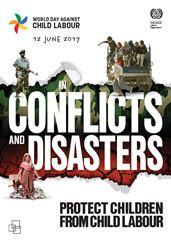
Statement from ILO
Today, on World Day Against Child Labour, 2017 , we are emphasizing the plight of children caught up in conflicts and disasters, and who are at particular risk of child labour.
In areas affected by conflict and disaster, homes and schools are often destroyed. Many families lose their means to earn a living. Family and social protection systems break down and increase the risk of child labour. Child refugees and migrants, particularly those on the move who are separated from their families, are especially vulnerable and can easily fall prey to trafficking and child labour.
Those who stay – or are left – behind are especially vulnerable to the worst forms child labour, including in mining or scavenging for metal and minerals in war-torn areas, clearing rubble, or working in the streets. In the most extreme cases, children find themselves as combatants fighting adult wars. Others are used by armed forces or groups as spies, helpers and porters – or become victims of sexual exploitation and abuse.
All children have the right to be protected from child labour. Yet, around the world, there are still 168 million children in child labour. Eighty-five million of them are engaged in hazardous work.
Today, we are facing the greatest refugee crisis for decades. Neighbouring host countries are shouldering a huge part of the world’s responsibility to provide sanctuary and support to children and their families. Much more needs to be done to share fairly the responsibility to protect refugees and, especially, to support those states on the front line in the affected regions, so that they can provide access to the labour market for adult refugees and access to education for their children.
Under Target 8.7 of the UN’s 2030 Sustainable Development Goals , all countries have committed to eliminating all forms of child labour by 2025. This target can only be achieved if no child is left behind – no matter how difficult and challenging the circumstances. The international community is paying more and more attention to this challenge, but more needs to be done.
The ILO works closely with its government and employers’ and workers’ constituents, as well as with other international organizations, civil society and the media to support children affected by child labour in conflicts and disasters. Children from Haiti to Myanmar, and from Nepal to the Democratic Republic of Congo, have been withdrawn from child labour and found an alternative in quality education.
The ILO’s Minimum Age Convention, 1973 (No. 138) and the Worst Forms of Child Labour Convention, 1999 (No. 182) have now been ratified by 169 and 180 member States respectively. Tomorrow I will have the honour of receiving India’s ratification of both Conventions. That great step forward towards universal ratification will mean that almost all children in the world will be covered by Convention 182; and that coverage of Convention 138 will leap from sixty per cent to eighty per cent. Together with the near universal ratification of the Convention on the Rights of the Child, that sends a resounding message about our common cause – and our common standards that protect children’s human rights.
In September 2016, the ILO, with its partners, launched Alliance 8.7 , a global partnership to end child labour, forced labour, modern slavery and human trafficking by concrete action, as established in target 8.7 of the 2030 Agenda for Sustainable Development. ILO’s IPEC + flagship programme supports member States and social partner constituents in their efforts to face the challenge. In September 2017, together with other partners, the ILO will present new Global Estimates and a World Report on Child Labour. The ILO also thanks Argentina, who will host the IV Global Conference on the Sustained Eradication of Child labour in November this year and actively supports the preparations.
So wherever you are in the world, join us in marking World Day Against Child Labour ! There is no time to lose. Now is the time to intensify our action to accelerate progress towards ending all forms of child labour.
Globally over 1.5 billion people live in countries that are affected by conflict, violence and fragility. At the same time, around 200 million people are affected by disasters every year. A third of them are children. A significant proportion of the 168 million children engaged in child labour live in areas affected by conflict and disaster. The World Day Against Child Labour this year will focus on the impact of conflicts and disasters on child labour.
Conflicts and disasters have a devastating impact on people’s lives. They kill, maim, injure, force people to flee their homes, destroy livelihoods, push people into poverty and starvation and trap people in situations where their basic human rights are violated. Children are often the first to suffer as schools are destroyed and basic services are disrupted. Many children are internally displaced or become refugees in other countries, and are particularly vulnerable to trafficking and child labour. Ultimately, millions of children are pushed into child labour by conflicts and disasters.
As the world strives to achieve the elimination of child labour by 2025, on this World Day Against Child Labour, let’s join forces to end child labour in areas affected by conflict and disaster!
Child labour and forced labour in conflicts and humanitarian settings will be discussed at the IV Global Conference on Child Labour (Buenos Aires, 14-16 November 2017).
Monday, 12 June 2017 - Event to mark the World Day Against Child Labour during the ILC
In Geneva, the World Day Against Child Labour is marked by an event held on 12 June 2017, at 1:30 p.m., at Michelangelo Pistoletto’s “Rebirth” sculpture in Parc l’Ariana at the Palais des Nations.
This event takes place during the 106th Session of the International Labour Conference, and is organized by the ILO in collaboration with the United Nations Office, Geneva and Cittadellarte – Fondazione Pistoletto.










Add new comment